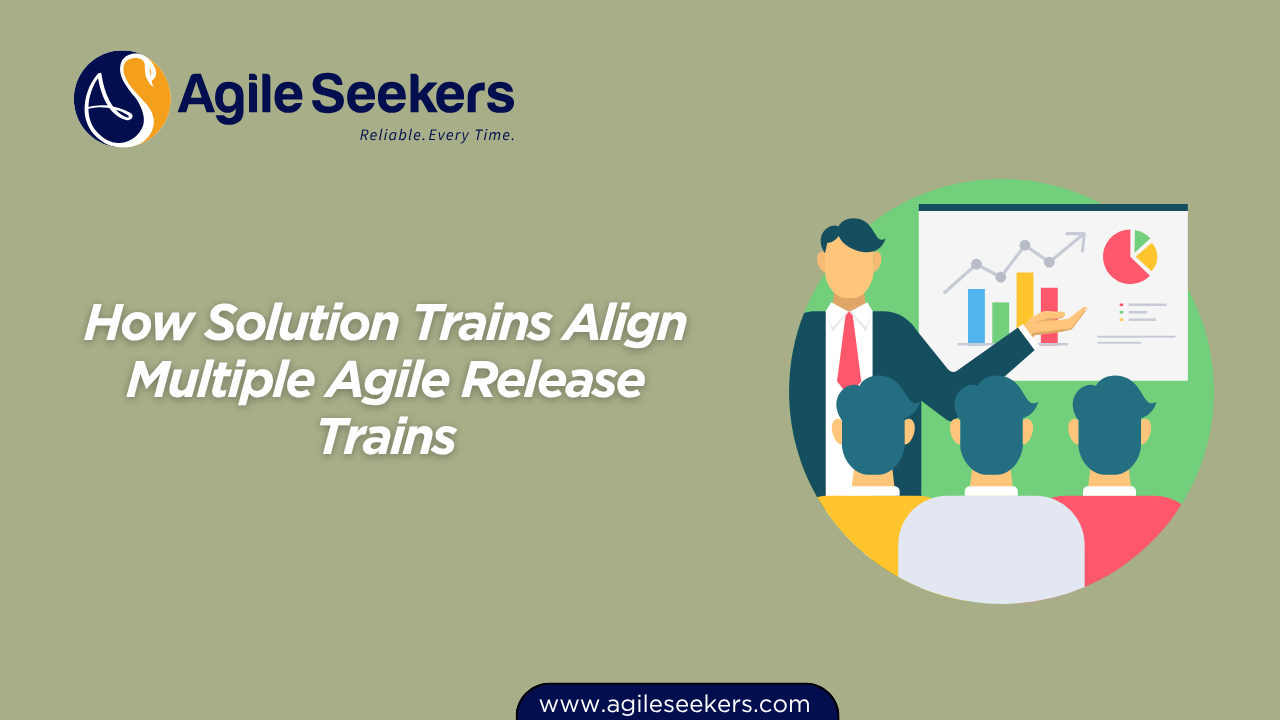How Solution Trains Align Multiple Agile Release Trains

As organizations scale Agile beyond a single Agile Release Train (ART), they often encounter the challenge of aligning multiple ARTs toward a common solution. This is where the Solution Train comes into play—a higher-level coordination mechanism in the SAFe® framework that ensures multiple ARTs, suppliers, and stakeholders are aligned around large-scale solution delivery.
This blog post explores how Solution Trains coordinate multiple ARTs for enterprise-level delivery, the roles involved, and how they support alignment, governance, and flow across large systems.
What Is a Solution Train?
A Solution Train is a construct in SAFe used to build and evolve the largest and most complex solutions. It coordinates the efforts of multiple Agile Release Trains and suppliers to deliver capabilities that one ART alone cannot produce.
This is especially relevant in industries like aerospace, defense, telecom, or automotive—where a single solution includes hardware, software, and systems integration.
Key Roles Driving Solution Trains
Solution Trains include a set of roles and artifacts similar to those in ARTs, but scaled to address enterprise complexity:
| Role | Responsibility |
|---|---|
| Solution Train Engineer (STE) | Facilitates and coordinates multiple ARTs; acts like a Chief Scrum Master at the solution level. |
| Solution Management | Owns the Solution Backlog, defines Capabilities, and aligns solution features with customer needs. |
| Solution Architect/Engineering | Defines architectural runway and ensures design integrity across ARTs and suppliers. |
| Suppliers | External partners who deliver components or subsystems aligned to the overall solution vision. |
Each of these roles collaborates closely with Release Train Engineers (RTEs), Scrum Masters, and Product Management across the trains.
To understand the role of the Release Train Engineer, explore the SAFe Release Train Engineer Certification course.
Aligning Backlogs Across ARTs
Solution Trains manage a Solution Backlog that operates one level above the Program Backlogs of individual ARTs. Items in the Solution Backlog—such as Capabilities—are split into Features that flow into ARTs.
This backlog hierarchy ensures that delivery across trains aligns to a cohesive solution vision. Scaling Product Ownership across trains is essential here, which you can dive deeper into through the SAFe POPM Certification.
The Role of Solution Intent and Compliance
Large solutions often face regulatory or compliance requirements. Solution Trains manage Solution Intent—a single source of truth that captures fixed and variable solution requirements, design, tests, and compliance information.
This shared understanding prevents ARTs from drifting in separate directions and helps maintain architectural integrity.
To appreciate how SAFe supports architectural alignment across trains, the Leading SAFe Certification includes a deep dive into solution-level constructs.
Planning at Scale: Pre- and Post-PI Planning
Coordinating multiple ARTs means synchronization before and after Program Increment (PI) planning.
-
Pre-PI Planning: Aligns vision, roadmap, and cross-train dependencies before ARTs conduct their individual PI planning.
-
Post-PI Planning: Validates the committed plans across ARTs and ensures integration points are realistic.
This ensures cross-team coordination, reduces risk, and improves delivery predictability.
Explore how this coordination is enabled by roles like SAFe Scrum Master, whose facilitation skills are critical across trains. Learn more in the SAFe Scrum Master Certification.
Managing Dependencies and Risks
A Solution Train handles systemic risks and cross-ART dependencies that would otherwise block enterprise delivery. Tools like Dependency Maps, Risk Roams, and Milestone Reviews help align teams to critical paths.
To strengthen facilitation at scale, Scrum Masters often evolve into SAFe Advanced Scrum Masters, gaining the skills to coach and lead in complex ART networks. The SAFe Advanced Scrum Master Certification is designed for this advanced role.
Metrics That Matter Across Solution Trains
To assess and improve Solution Train performance, SAFe recommends metrics that span across ARTs:
-
Solution Velocity: Measures throughput at the capability level.
-
Integration Burndown: Tracks how well integrated systems are evolving.
-
Objective Achievement: How aligned ART outcomes are with enterprise OKRs.
Effective metric tracking supports Inspect and Adapt workshops at the solution level and drives meaningful improvement.
External Resource: Scaled Agile’s Metrics Guidance offers in-depth approaches to performance tracking.
Solution Demos: Closing the Loop
Solution Trains culminate their PI execution with a Solution Demo, showcasing integrated work from all ARTs and suppliers. This ensures enterprise stakeholders can inspect and provide feedback on system-level behavior and value delivery.
This is more than a showcase—it's a feedback loop critical for continuous delivery.
Final Thoughts
Coordinating multiple ARTs through a Solution Train is not just about scaling operations—it's about aligning strategy, architecture, and execution into a unified, value-driven delivery system. When done well, it brings clarity across silos, enhances customer value, and simplifies governance.
Whether you're a Scrum Master facilitating across teams, a Product Manager shaping cross-train features, or an RTE leading alignment, understanding the role of Solution Trains is essential for scaling Agile delivery.
For those looking to step into these roles, certifications such as Leading SAFe, POPM, SAFe Scrum Master, or RTE Certification provide the foundation to lead at scale.
Also read - How Capabilities Evolve Across ARTs in Large Solution Trains
Also see - Cadence vs Synchronization in ARTs: Why Both Are Critical for System Thinking




















